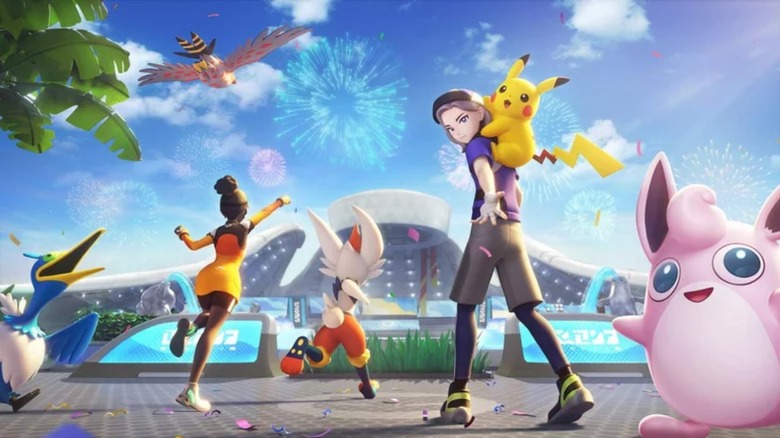Pokemon Unite Review: Big Fun, Big Concerns
- Gameplay is surprisingly fun and addictive
- Pokemon each feel unique and, for the most part, effective
- Matches are short, a rare sight for MOBAs
- Too many free currencies make getting what you want confusing
- Caps on Aoes Coins limit the rate at which free-to-play players can obtain new Pokemon
- Has a pay-to-win mechanic through Item Enhancers that can be purchased with paid currency
- Late-game balance needs some work
If you thought that Pokemon Unite would be a lackluster attempt at a Pokemon-themed MOBA, you definitely aren't alone. Pre-release trailers didn't do the game any favors, but now that it's here, the people who gave it a chance are finding that it's actually a lot of fun to play. Not only that, but Pokemon Unite could potentially serve as a good introduction for MOBA newcomers, turning an entirely new generation of people onto a genre that often feels like it's winding down.
Unfortunately, the realization that Pokemon Unite is actually a fun game comes with some other, less wonderful revelations. While Pokemon Unite offers a good time, it has some clear issues with balance. Those balance issues can be fixed through player feedback and patching, though. What's particularly concerning about this game is the sheer number of currencies – both paid and free – that it offers, and the fact that those who are willing to pay can get gameplay advantages over those who are not.
MOBA-lite or something greater?
On balance, it's tricky to write a review of a game like Pokemon Unite. First of all, we have the fact that what I'm reviewing today probably won't be the game that people are playing in a couple of months thanks to changes in the meta, the introduction of new Pokemon, and even the possibility of new mechanics being added. More concerning to me, though, is the tricky dichotomy between the fact that the game really is a lot of fun and the fact that TiMi Studio Group (the game's developer and a subsidiary of Tencent) and The Pokemon Company have no issue with putting pay-to-win mechanics in a game that's not only competitive but also one that children are sure to play.
Gameplay in Pokemon Unite can be best summed up as "MOBA-lite." As in more complex MOBAs like League of Legends, Dota 2, and Heroes of the Storm, Pokemon Unite pits two teams of five players against one another. Pokemon Unite's map has two lanes with four scoring zones – two for each team – along with a fifth scoring zone for each team, located where the two lanes meet in front of each team's base.
The goal is to defeat wild Pokemon dotted around the map, and the Pokemon on the opposing team, to collect energy, which you then take to one of the opposing team's goal zones to score. When you die, you'll be taken out of the game for a set amount of time that gets longer as the game goes on, making late-game deaths much more severe than those early on. You'll also drop a portion of the energy you were carrying, allowing other players to potentially pick it up and add it to their own score.
As you play through a match and defeat opposing and wild Pokemon, your own character will level up, gaining more health and attack damage along with new and upgraded abilities at certain levels. Each Pokemon has a basic attack, two regular abilities on short cooldown timers, and an ultimate ability on a long cooldown timer. Using these abilities at the right time is often key to winning fights, and dodging skillshots from your opponents can be the difference between winning a fight and losing one.
Pokemon Unite streamlines a lot of the MOBA experience. Matches are only 10 minutes long, and no minion waves are marching down lanes at regular intervals like they do in pretty much every other MOBA under the sun. Goal zones replace towers and, while they give defensive bonuses to their team's players and are destroyed after the enemy team scores 100 points at them, they don't fire at enemies like traditional MOBA towers do.
While there are items that give stat boosts, they're part of an account inventory and are equipped before a match even begins rather than purchased during a match. Instead of having players buy items during a match to upgrade their characters, abilities are upgraded automatically at certain levels, becoming stronger or, in some cases, changing entirely. Players are even given a choice between upgrading into two different skills at certain tiers, which gives each Pokemon some build variety and the ability to switch it up between matches.
I quite like the leveling system Pokemon Unite has to offer. I'm a bit of a casual MOBA player as I'm coming from Heroes of the Storm, so I'm not used to buying items throughout the course of a match anyway. However, Pokemon Unite's changing abilities are somewhat reminiscent of Heroes' talents, so I feel right at home.
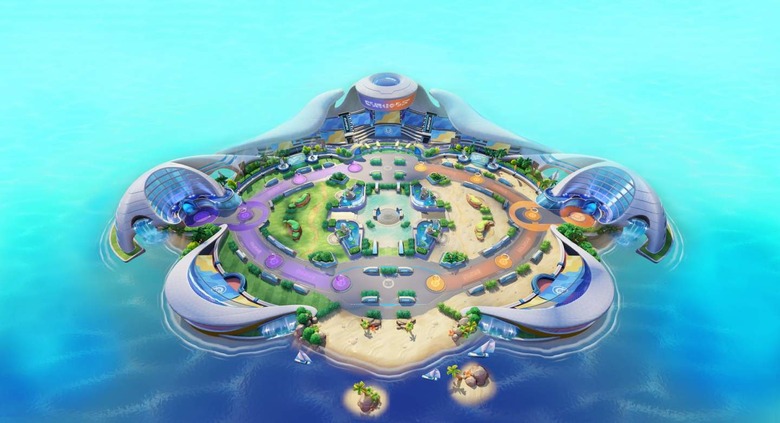
The gameplay in Pokemon Unite is fast-paced and unexpectedly addictive. There's less focus on macro play, but knowing when to rotate in-between lanes to keep the pressure on the enemy team can certainly help. While it's tempting to just run down a lane and fight the opposing players as often as possible, defeating wild Pokemon is how you'll get a level lead in the early game, and a level lead then can help your team snowball to a victory.
Teamfights in Pokemon Unite are often a dazzling display of abilities. Pokemon are split into five different types: Defender, Supporter, Attacker, All-Rounder, and Speedster. Defenders are the tanks of Pokemon Unite; they have a lot of HP to soak damage and often have some type of crowd control that can help damage dealers line up kills. Attackers are pretty self-explanatory, as they're squishy characters who die quickly when they're out of position, but they can really pile on the damage with their ranged attacks.
Supporters can heal or buff teammates, hinder opponents, or perform some mix of both. Speedsters are the junglers of Pokemon Unite, and they excel at clearing the wild Pokemon from the middle of the map before rotating into lanes at the right time to help their teammates secure kills. Finally, we have All-Rounders, who are the Pokemon that don't seem to fit into any other group particularly well. These Pokemon are typically the melee damage dealers, and they tend to have more health than their ranged Attacker counterparts.
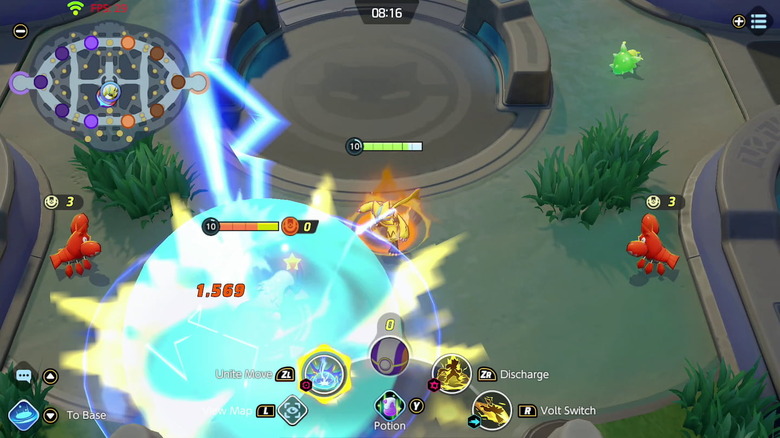
While MOBAs typically want you to have a balanced team, you can often get away with playing the role you want in Pokemonm Unite, at least in lower levels. Of course, at higher levels of organized play, you'll benefit by having a Defender, Supporter, and Speedster on your team, but I've won plenty of matches where most of my team was comprised of Attackers, All-Rounders, and a single Supporter or Speedster.
I was completely caught off guard by how fun Pokemon Unite is. I went in expecting very little, but Pokemon Unite managed to impress. I wonder about Pokemon Unite's longevity considering its more streamlined matches, but for now, at least, I'm having a ton of fun with this game.
Everybody focus the bird
That said, there is one glaring issue with how Pokemon Unite matches often play out. While most wild Pokemon in the game don't do anything outside of awarding experience and points when they're defeated, some wild Pokemon grant major bonuses. These buffs can range from strong to outright game-changing, but there's one boss Pokemon that I have issues with specifically: Zapdos.
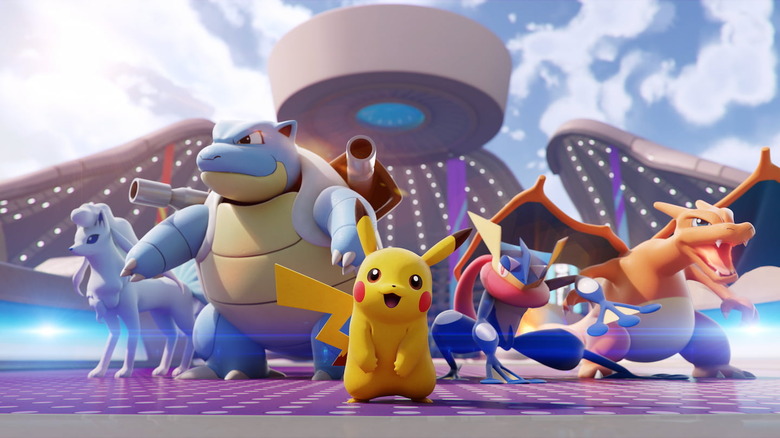
Zapdos spawns in the middle of the map when there are two minutes left in a match. When defeated, Zapdos gives the player who performed the last hit 30 points and everyone else on that player's team 20 points. Zapdos also gives the team that defeated it an instant score buff that lasts for 30 seconds, meaning the team with that buff can just walk into their opponent's goal zone and score by pressing the X button. There's no wind-up necessary, so once they're in the goal zone, there's no realistic chance of stopping them from scoring.
This is problematic for a couple of reasons. For starters, in the last two minutes of the game, all scoring is doubled: the team that kills Zapdos can swing the score heavily in their favor in a span of seconds. I don't have a problem with comeback mechanics, but as the meta becomes more defined in the coming weeks, you're going to see most games revolve around the last two minutes of play and that Zapdos buff.
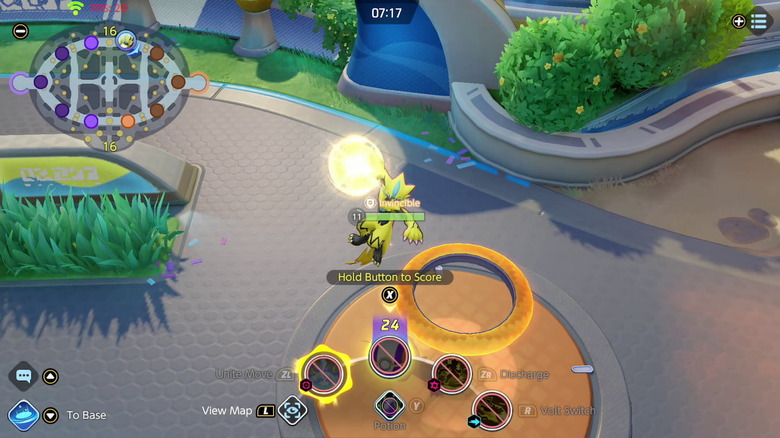
I like the idea of upping the stakes in the final minutes of the game and giving the losing team a chance to come back because it's never fun to be on the losing end of a blowout. The problem is that having Zapdos award 110 points to the team that beat it and leaving all enemy goal zones defenseless during the last two minutes of the game where all goals are doubled is too much. If Zapdos is going to be that game-changing, it really feels like scoring should not double in the last two minutes of a match.
I also really hate the last hit mechanics for wild boss Pokemon. I understand that last hitting is a core mechanic in MOBAs, and I think it works for other wild Pokemon, but for boss Pokemon, the buffs that the game is doling out are too powerful to be determined by last hits.
Personally, I'd far prefer it if boss Pokemon created a capture point that needs to be occupied by only one team for a few seconds before they're granted the buffs and bonuses. This way, you still encourage fights over the boss Pokemon, and one team still has a chance to steal those boss buffs, but they have to commit to a proper team fight to do it rather than sending in a rogue ranged attacker to land the final hit and run away (or indeed die).
The currency and pay-to-win problem
So the gameplay is fun, but there are some major balance concerns with the structure of matches and the fact that Zapdos is so powerful. That stuff can all be fixed in patches if TiMi Studio decides that matches are too frequently being decided in the last two minutes, so I'm not as concerned about those. However, I am concerned about this game's free-to-play structure because it's downright appalling for a game that's primarily targeted at children.
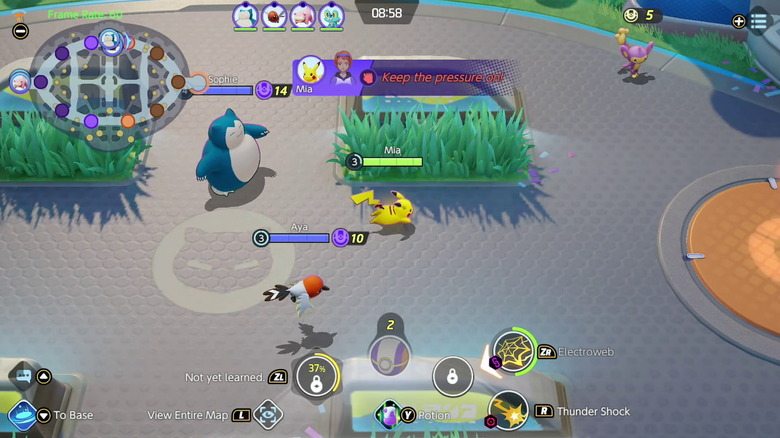
Depending on how you want to classify currencies, Pokemon Unite has no less than five of them. Only one of these currencies – Gems – can be purchased directly with real money. You'll use these currencies to buy pretty much everything in the game, from cosmetic items to new Pokemon (you'll need to purchase a Pokemon's Unite License before you can use it in matches) to entire outfits for both your trainer avatar and your Pokemon.
There are four other currencies that you'll get as you play the game: Aeos Coins, Aeos Tickets, Fashion Tickets, and Holowear Tickets. In the beginning, it's pretty easy to rack up decent stockpiles of each currency, as the current launch promotions tend to send a lot your way. You'll also get new items and currencies by increasing your trainer level, which happens naturally through playing the game, or by leveling up your Battle Pass, which has both a free and a paid version that can be purchased using Gems.
Once these launch promotions and the trainer level track end, though, it seems that the rate at which you earn currencies will slow to a crawl. The hope is that TiMi Studio will keep the events rolling after we get past all of these launch promotions because otherwise it seems like the flow of currencies is going to slow dramatically for free-to-play players – and that's especially true when you consider that you're limited to earning a max of 2,100 Aeos Coins per week from battles, which considerably slows the rate at which you can obtain new Pokemon if you aren't going to pay for them with Gems.
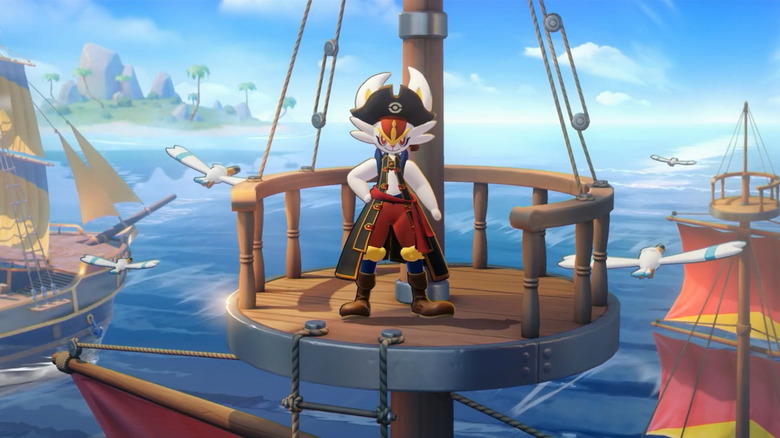
Then we have the pay-to-win elephant in the room. There has been much debate over whether Pokemon Unite is pay-to-win, and we're going to settle that now. As far as I'm concerned, this game does have pay-to-win mechanics, and that's a big shame considering that kids are probably going to flock to this game en masse.
The problem stems from held items and how they're upgraded. Every held item grants Pokemon stats and special perks. Those stat bonuses increase as you level up those held items, which can only be done using Item Enhancers. The game gives you a decent amount of Item Enhancers by leveling the battle pass, working your way through the trainer level track, and completing event challenges, but not enough to upgrade all of the held items you'll probably want to upgrade. When you run out of the free Item Enhancers, you can purchase more from the in-game shop using Aeos Tickets.
So far, this is fine because Aeos Tickets are a free-to-play currency that you can't buy. However, once you run out of Aeos Tickets, the game reveals that you can purchase more Item Enhancers using Gems, the only currency you can buy with money. That means those willing to pay their way can upgrade held items much faster than free-to-play players, giving them a larger advantage in-game.
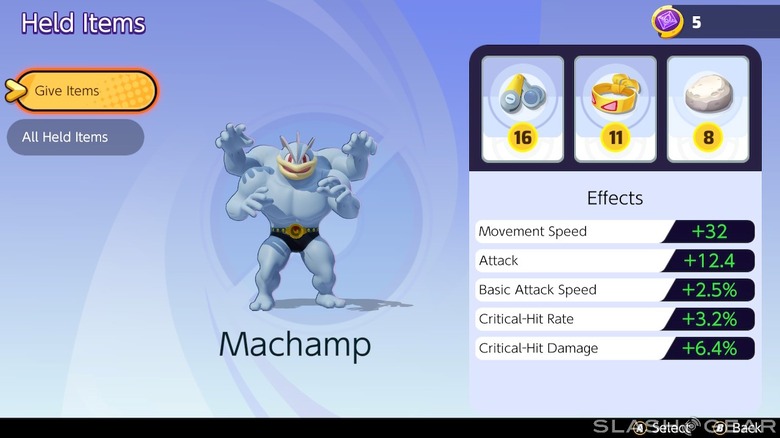
This is a pay-to-win mechanic, full stop. I've seen arguments that claim this isn't truly pay-to-win because free-to-play players will still be able to max out items, albeit on a longer timeline, but frankly, that's nonsense. The timeline for a free-to-play player to max out items is quite possibly months-long, but at the very least, it's far longer than someone willing to pay to upgrade all their items now. I define pay-to-win as a mechanic that gives paying players an advantage over free-to-play players, and that's precisely what this does.
I've also seen arguments that claim the stat boosts from items are not that significant, but in a MOBA like this, a few percentage points can make a huge difference between equally matched players. Let's look at the Muscle Band, a held item that most Pokemon who do physical damage will want to equip.
The Muscle Band grants Pokemon a flat attack boost and a percentage boost to basic attack speed. At level 0, the flat attack boost is +1, while at max level (which is level 30 and takes a huge number of Item Enhancers to reach), it's +15. That's not very big in the grand scheme of things, but the real kicker comes in with the attack speed boost. At level 0, the Muscle Band doesn't grant an attack speed boost at all, but at max level, it increases basic attack speed by 7.5%.
Anyone who has played a MOBA before will tell you that a permanent 7.5% attack speed boost is a big difference-maker, particularly between even-keeled players. It may not make a huge difference when you're in a lopsided game, but in the close games where every stat boost and percentage point counts, it could absolutely be the deciding factor in a head-to-head fight. I am incredibly disappointed to see this kind of pay-to-win mechanic in a game like Pokemon Unite, and the fact that Tencent and The Pokemon Company seemingly tried to hide it makes things even worse.
Pokemon Unite Verdict
This is a tough game to judge. I really enjoy playing Pokemon Unite and, were I judging the gameplay alone, it would get a solid 8 or maybe even a 9. It's a ton of fun to play, and each Pokemon feels unique. So far, I haven't had a bad time playing, even when I'm losing a match, and there's a part of me that's very excited to see what kind of Pokemon get added in the future and how they shake up the meta. I am completely astounded by how much I enjoy playing, frankly, because I was ready to write off Pokemon Unite before release.
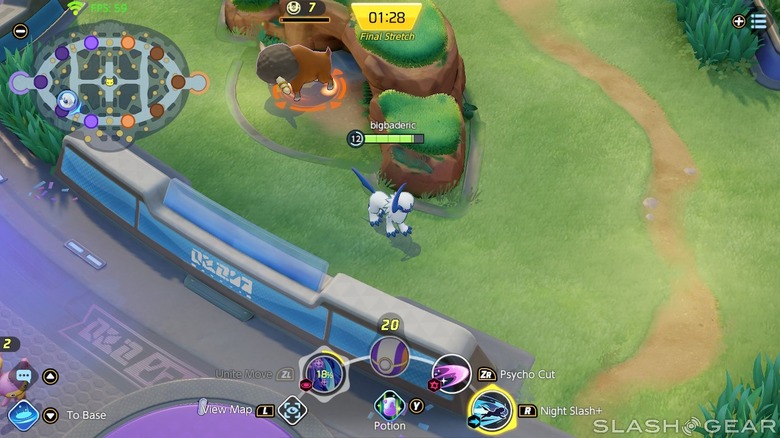
However, I can't in good conscience give Pokemon Unite that high of a rating when it has so many problems outside of the game (and even a few inside it). Furthermore, there is no excuse to put the kind of pay-to-win mechanic I described above in a game that will be marketed to, and played by, children. Attaching such a mechanic to a children's brand is gross, and Nintendo and The Pokemon Company should be embarrassed that they allowed a franchise as popular as Pokemon to be associated with tactics such as this.
Even if there weren't a pay-to-win mechanic hidden away in the depths of Pokemon Unite, the fact remains that there are too many currencies in this game. I understand that a free-to-play game needs to have some way to make money, but we honestly should just have one paid currency and one free-to-play currency – Gems and Aeos Coins. There is no reason to have one paid currency and four free-to-play currencies unless the goal is to confuse players to the point where it's easier just to bust out a credit card and buy what you want directly (which I suspect it is).
It really is a shame that Pokemon Unite has been monetized to hell and back because it's so much fun otherwise. I really hope that The Pokemon Company reconsiders what kind of game it has its name attached to here and prompts some kind of change – I'm guessing that TiMi Studio isn't going to do it on its own. Until that happens, though, I can only give a tepid recommendation to adults who understand what they're getting themselves into.
